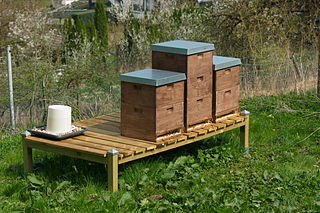Related Research Articles

Bees are winged insects closely related to wasps and ants, known for their roles in pollination and, in the case of the best-known bee species, the western honey bee, for producing honey. Bees are a monophyletic lineage within the superfamily Apoidea. They are currently considered a clade, called Anthophila. There are over 20,000 known species of bees in seven recognized biological families. Some species – including honey bees, bumblebees, and stingless bees – live socially in colonies while most species (>90%) – including mason bees, carpenter bees, leafcutter bees, and sweat bees – are solitary.

A honey bee is a eusocial flying insect within the genus Apis of the bee clade, all native to mainland Afro-Eurasia. After bees spread naturally throughout Africa and Eurasia, humans became responsible for the current cosmopolitan distribution of honey bees, introducing multiple subspecies into South America, North America, and Australia.
Beekeeping is the maintenance of bee colonies, commonly in man-made beehives. Honey bees in the genus Apis are the most commonly kept species but other honey producing bees such as Melipona stingless bees are also kept. Beekeepers keep bees to collect honey and other products of the hive: beeswax, propolis, bee pollen, and royal jelly. Other sources of beekeeping income include pollination of crops, raising queens, and production of package bees for sale. Bee hives are kept in an apiary or "bee yard".

Apitherapy is a branch of alternative medicine that uses honey bee products, including honey, pollen, propolis, royal jelly and bee venom. There has been no scientific or clinical evidence for the efficacy or safety of apitherapy treatments.

Halictidae is the second-largest family of bees with nearly 4,500 species. They are commonly called sweat bees, as they are often attracted to perspiration. Halictid species are an extremely diverse group that can vary greatly in appearance. These bees occur all over the world and are found on every continent except Antarctica. Usually dark-colored and often metallic, halictids are found in various sizes, colors and patterns. Several species are all or partly green and a few are red, purple, or blue. A number of them have yellow markings, especially the males, which commonly have yellow faces, a pattern widespread among the various families of bees. The family is one of many with short tongues and is best distinguished by the arcuate basal vein found on the wing. Females in this family tend to be larger than the males. They are the group for which the term 'eusocial' was first coined by entomologist, Suzanne Batra.

In beekeeping, a Langstroth hive is any vertically modular beehive that has the key features of vertically hung frames, a bottom board with entrance for the bees, boxes containing frames for brood and honey and an inner cover and top cap to provide weather protection. In a Langstroth hive, the bees build honeycomb into frames, which can be moved with ease. The frames are designed to prevent bees from attaching honeycombs where they would either connect adjacent frames, or connect frames to the walls of the hive. The movable frames allow the beekeeper to manage the bees in a way which was formerly impossible.

The Caucasian honey bee is a subspecies of the western honey bee.

Melittology is a branch of entomology concerning the scientific study of bees. It may also be called apiology or apicology. Melittology covers the species found in the clade Anthophila within the superfamily Apoidea, comprising more than 20,000 species, including bumblebees and honey bees.

May Roberta Berenbaum is an American entomologist whose research focuses on the chemical interactions between herbivorous insects and their host plants, and the implications of these interactions on the organization of natural communities and the evolution of species. She is particularly interested in nectar, plant phytochemicals, honey and bees, and her research has important implications for beekeeping.

The western honey bee or European honey bee is the most common of the 7–12 species of honey bees worldwide. The genus name Apis is Latin for "bee", and mellifera is the Latin for "honey-bearing" or "honey carrying", referring to the species' production of honey.

Commercial Beekeeping in the United States dates back to the 1860s.

Beekeeping in New Zealand is reported to have commenced in 1839 with the importing of two skep hives by Mary Bumby, a missionary. It has since become an established industry as well a hobby activity.
Gene Ezia Robinson is an American entomologist, Director of the Carl R. Woese Institute for Genomic Biology and National Academy of Sciences member. He pioneered the application of genomics to the study of social behavior and led the effort to sequence the honey bee genome. On February 10, 2009, his research was famously featured in an episode of The Colbert Report whose eponymous host referred to the honey Dr. Robinson sent him as "pharmaceutical-grade hive jive".
Beekeeping in the United Kingdom is the maintenance of bee colonies by humans within the United Kingdom. It is a significant commercial activity that provides those involved with honey, beeswax, royal jelly, queen bees, propolis, flower pollen and bee pollen. Honeybees also provide pollination services to orchards and a variety of seed crops.

Propolis or bee glue is a resinous mixture that honey bees produce by mixing saliva and beeswax with exudate gathered from tree buds, sap flows, or other botanical sources. It is used as a sealant for unwanted open spaces in the beehive. Propolis is used for small gaps, while gaps larger than the bee space are usually filled with burr comb. Its color varies depending on its botanical source, with dark brown as the most common. Propolis is sticky above 19 °C (66 °F), while at lower temperatures, it becomes hard and brittle.

Thomas Dyer Seeley is the Horace White Professor in Biology in the Department of Neurobiology and Behavior at Cornell University. He is the author of several books on honeybee behavior, including Honeybee Democracy (2010) and The Wisdom of the Hive (1995) He was the recipient of the Humboldt Prize in Biology in 2001. He primarily studies swarm intelligence by investigating how bees collectively make decisions.

Lasioglossum vierecki, also known as Dialictus vierecki and Halictus vierecki, is a sand sweat bee and is part of the family Halictidae of the order Hymenoptera. It is found in the eastern half of North America from Minnesota to the New England States down to Georgia and Louisiana and up in Manitoba and Ontario. Commonly found in sandy areas, it pollinates various flowers such as grass-leaved goldenrod and rattlesnake master.
Christina Grozinger is an American entomologist, the Publius Vergilius Maro Professor of Entomology at Pennsylvania State University and the director at its Center for Pollinator Research.

Frank Benton was an American entomologist, researcher, beekeeping innovator and author.
References
- ↑ "Ten Entomologists Join the Ranks of Fellows of the Entomological Society of America | Entomological Society of America". Archived from the original on 2017-11-10. Retrieved 2017-11-09.
- ↑ "Home". beelab.umn.edu.
- ↑ "Ten Entomologists Join the Ranks of Fellows of the Entomological Society of America". Archived from the original on November 10, 2017. Retrieved November 9, 2017.
- ↑ "Previous Hambleton Award Recipients". Archived from the original on September 1, 2012. Retrieved November 11, 2017.
- ↑ "Ten Entomologists Join the Ranks of Fellows of the Entomological Society of America | Entomological Society of America". Archived from the original on 2017-11-10. Retrieved 2017-11-09.
- ↑ "Archived copy" (PDF). Archived from the original (PDF) on 2017-07-13. Retrieved 2016-10-25.
{{cite web}}: CS1 maint: archived copy as title (link) - ↑ "Ten Entomologists Join the Ranks of Fellows of the Entomological Society of America | Entomological Society of America". Archived from the original on 2017-11-10. Retrieved 2017-11-09.
- ↑ "Marla Spivak : Department of Entomology : College of Food, Agricultural and Natural Resource Sciences : University of Minnesota". Archived from the original on 2014-08-25.
- ↑ "Marla Spivak — MacArthur Foundation".
- ↑ dalyx224 (2014-08-11). "Marla Spivak". Department of Entomology. Retrieved 2019-03-07.
{{cite web}}: CS1 maint: numeric names: authors list (link) - ↑ Spivak, Marla (December 2008). "The Future of the MN Hygienic Stock of Bees is in Good Hands!". American Bee Journal . 149 (10): 965–967. Retrieved August 8, 2015.
- ↑ Spivak, Marla. "The Future of the MN Hygienic Stock of Bees is in Good Hands!". ResearchGate. Retrieved 28 January 2021.
- ↑ McNeil, M.E.A. (September 2010). "Getting bees back on their own six feet" (PDF). American Bee Journal . Archived from the original (PDF) on 2019-03-08. Retrieved October 25, 2016.
- ↑ Lee, Katie (June 2011). "Origins". Bee Informed Partnership Blog . Archived from the original on 2020-11-29. Retrieved October 25, 2016.
- ↑ "Tech Teams - Bee Informed Partnership".
- ↑ Spivak, Marla (March 2013). "The Benefits of Propolis" (PDF). Bee Craft Magazine. Retrieved August 8, 2015.
- ↑ Miller, Kerri (April 1, 2013). "With hives in sharp decline, expert calls for bee-friendly flowers". MPR News . Retrieved August 8, 2015.
- ↑ Ross, Jenna (September 28, 2010). "Buzz about U professor is 'genius'". Star Tribune . Retrieved April 25, 2014.
- ↑ Horn, Tammy (November 1, 2011). Beeconomy: What Women and Bees Can Teach Us about Local Trade and the Global Market. University Press of Kentucky. p. 170. ISBN 9780813134369.
- ↑ hvander (2015-01-27). "Bee Squad". Bee Lab. Retrieved 2019-03-08.
- ↑ "Bee Squad : Bee Lab : Department of Entomology : University of Minnesota". Regents of the University of Minnesota. 2014. Archived from the original on 2013-04-14.
- ↑ "Distinguished Service Award". AgriGrowth. 2016.
- ↑ Anonymous (16 March 2016). "Siehl Prize for Excellence in Agriculture announces 2016 laureates".
- ↑ "2016 Women of Discovery Awards". WINGS WorldQuest. Archived from the original on 2016-09-01.
- ↑ "Ten Entomologists Join the Ranks of Fellows of the Entomological Society of America | Entomological Society of America". Archived from the original on 2017-11-10. Retrieved 2017-11-09.
- ↑ Gardner and Gibbs (December 2020). "The 'red-tailed' Lasioglossum (Dialictus) (Hymenoptera: Halictidae) of the western Nearctic". European Journal of Taxonomy (725): 1–242. doi: 10.5852/ejt.2020.725.1167 . S2CID 229449584 . Retrieved December 6, 2020.